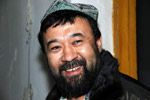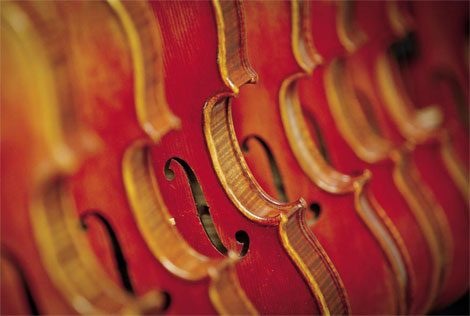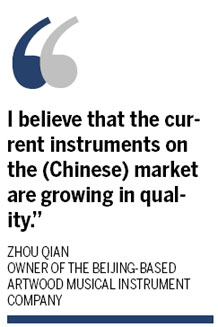Business
Violin makers carving out a larger niche
Updated: 2011-02-16 10:49
By Eric Jou and Hu Haiyan (China Daily)
|
|
BEIJING - For Wang Zhiming, the violin has always been more than a musical instrument.
"My grandfather was an instrument tuner and maker, and my father was an instrument maker as well," said Wang. "I grew up playing the violin and running around instrument factories."
The 51-year-old is now the owner of Beijing-based Lu Mi Strings Instrument, a maker of high-end, made-to-order Chinese violins that currently employs 18 and manufactures about 2,400 violins a year. He is one of many Beijing violin makers in a country that supplies more than 70 percent of the world's violins.
China is the world's leading producer of musical instruments, including stringed, electric and traditional instruments. China exports about 630,000 violins a year, of which nearly one-third is produced in Beijing, according to the Chinese Musical Instrument Association (CMIA).
According to the CMIA, exports from the Chinese musical instrument industry accounted for nearly $166 billion in revenue through the first three quarters of last year.
But until recently, violins made in China were considered merely as mass-produced products that were poorer in quality compared to the stringed instruments made in the United States or Europe. Now with improvements in standards, China's violin makers say they are getting more attention from professional luthiers from all over the world.
"I believe that the current instruments on the (Chinese) market are growing in quality," said Zhou Qian, owner of the Beijing-based Artwood musical instrument company.
At least one US instrument retailer agrees. David Segals Ltd, a high-end violin retailer in New York City, said that Chinese-made violins are attractive because they are inexpensive and flawlessly constructed.
"We're probably one of the primary violin dealers in New York (City) that have been consistently selling Chinese violins, some of the better violins coming out China," said Diane Mellon, manager of David Segals Ltd. "We have been very supportive of these companies because in general I think they have put out a great product and have made violins affordable for more people, very decent violins that are not incredibly expensive."
She estimates that they sell at least one Chinese-made violin a week.
|
|
Still, some experts and craftsmen in the industry think China's violins have a way to go before garnering global accolades.
"Chinese violins and violin makers are winning awards worldwide," Wang said. "But we still haven't gotten out of the game of making our products as outsourced work."
Zhou, who is 50 and has been making violins for more than 30 years, said that one of the problems with domestic violins is not so much the quality but the branding and marketing of China's violins.
Chinese violin makers also have a tendency to imitate historical instruments and often recreate them to order for customers. Zhou and Wang both said that their most popular models have been high-end imitations of Antonio Stradivari's most famous works.
"China has only been making violins for about 70 years, so there is an obvious gap there. You cannot compare modern violins to old violins," Wang said. "Because the domestic violins are still young compared to foreign violins and brands, Chinese violins suffer a lack of prestige despite being of good quality and often are only recreations or copies of prestigious violins."
Apart from branding and the prestige of Western violins, Chinese violins are fundamentally different. Regardless of how they're made, what makes Chinese violins cheaper and different from American and European violins is the wood. Chinese violins are made of wood from the Xinjiang Uygur autonomous region as well as from Yunnan and Sichuan provinces.
A typical Chinese violin can sell for about $150 to $320, compared to a violin made in the US, which may go for upwards of $800 to $1,600, said Fu Yuankai, vice-secretary-general of the CMIA.
Zhou's violins have thus far been very well received. One of her Italian customers decided that they were no longer going to add their Italian brand to Zhou's Chinese violins. They instead designed a brand just for Zhou's Chinese violins. Zhou's violins, like Wang's, are exported mainly to the US and Europe through professional players, schools and professors.
While Chinese made violins are a boon to retailers and players, some might say the market might be dominated by Chinese violins, but New York City luthiers Christophe Landon, owner of Strings and Other Things, and Guy Rabut aren't worried.
"I myself have a joint venture in Shanghai called Harmony Music," Landon said. "I think Chinese violins are very well made, and there is a place on the market for them. They make a lot of small-size instruments for children and it helps a lot with musical education throughout the world."
Rabut said Chinese craftsmen have a different approach to making violins. Rabut said he focuses solely on the creation of new violins and other stringed instruments instead of recreations and remakes that the Chinese are making.
"It's apples and oranges. We're not comparing or competing in anyway," Rabut said.
The reception that Chinese violins are receiving in the US only shows that the passion and dedication of violin makers are paying off.
Zhang Ning from Hebei province has worked for Wang at the Lu Mi Strings Instrument since she was 22 and started with little or no passion in her craft. Now she said she has found immense pleasure in her work.
"I've been making violins for the last 15 years, when I started I came to Beijing just for the sake of working at a violin factory, originally I didn't have any interests in the violin," Zhang said. "I was only interested in the benefits that came from the job, but now I understand the instrument, the wood and the instrument comes alive as you carve it and then paint it.
Coming from the countryside this kind of work is great."
China Daily
Specials

Spring Festival
The Spring Festival is the most important traditional festival for family reunions.

Top 10
A summary of the major events both inside and outside China.

A role model
Alimjan Halik had been selected as the "Cyberspace Personality Who Moved the Hearts of the Chinese in 2010".

